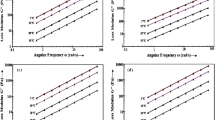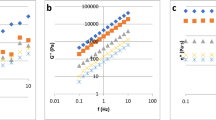Abstract
The purpose of this work was to investigate the physicochemical and rheological properties of Romanian honey, and particularly to analyze the influence of moisture content, °Brix concentration and temperature. All the samples were characterized to determine their physicochemical (moisture, °Brix, pH, ash, conductivity, colour, 5-hydroxymethylfurfural content, sugar content, diastase activity) and bioactive (antioxidant activity, total phenols content and total flavonoids content) parameters. All the investigated honeys displayed Newtonian behaviour at all temperatures. Four experimental viscosity models were checked using the experimental data to correlate the influence of temperature upon honey viscosity; The William-Landel-Ferry model was much suitable than Power Law, Arrhenius and Vogel-Taumman-Fulcher models for temperature-viscosity modelling. By using the polynomial modeling method, it was possible to develop a mathematical model to describe honey viscosity in the function of temperature and chemical composition. The model achieved, developed from the viscosity, temperature and chemical composition allows predicting the evolution of the dynamic viscosity.







Similar content being viewed by others
References
E. Anklam, A review of the analytical methods to determine the geographical and botanical origin of honey. Food Chem. 63, 549–562 (1998)
B. Fallico, M. Zappalà, E. Arena, A. Verzera, Effects of heating process on chemical composition and HMF levels in Sicilian monofloral honeys. Food Chem. 85(2), 305–313 (2004)
P.A. Sopade, P.J. Halley, B.R. D’Arcy, B. Bhandari, N. Caffin, Dynamic and steady-state rheology of Australian honeys at subzero temperatures. J. Food Process Eng. 27(4), 284–309 (2004)
A. Lazaridou, C.G. Biliaderis, N. Bacandritsos, A.G. Sabatini, Composition, thermal and rheological behaviour of selected Greek honeys. J. Food Eng. 64(1), 9–21 (2004)
L. Juszczak, T. Fortuna, Rheology of selected Polish honeys. J. Food Eng. 73(1), 43–49 (2006)
S. Yanniotis, S. Skaltsi, S. Karaburnioti, Effect of moisture content on the viscosity of honey at different temperatures. J. Food Eng. 72(4), 372–377 (2006)
K.M. Kang, B. Yoo, Dynamic rheological properties of honeys at low temperatures as affected by moisture content and temperature. Food Sci. Biotechnol. 17(1), 90–94 (2008)
B. Bhandari, B. D’Arcy, S. Chow, Rheology of selected Australian honeys. J. Food Eng. 41(1), 65–68 (1999)
B. Mossel, B. Bhandari, B. D’Arcy, N. Caffin, Use of Arrhenius model to predict rheological behaviour in some Australian honeys. LWT–Food Sci. Technol. 33, 545–552 (2000)
B. Abu-Jdayil, A. Al-Majeed Ghzawi, K.I.M. Al-Malah, S.J. Zaitoun, Heat effect on rheology of light- and darkcolored honey. J. Food Eng. 51(1), 33–38 (2002)
S. Bogdanov, Harmonised methods of the international honey commission (Swiss Bee Research Centre, FAM, Liebefeld, CH-3003 Bern, Switzerland, 2002)
J.B. Hutchings, Food color and appearance, 2nd edn. (Aspen Publishers, Gaithersburg, 1999)
P. Talens, N. Martinez-Navarrete, P. Fito, A. Chiralt, Changes in optical and mechanical properties during osmodehydrofreezing of kiwi fruit. Innov. Food Sci. Emerg. 3, 191–199 (2001)
V.L. Singleton, J.A. Rossi, Colorimetry of total phenolics with pho sphomolybdic-phosphotungstic acid reagents. Am. J. Enol. Vitic. 16, 144–158 (1965)
K. Dae-Ok, S.W. Jeong, C.Y. Lee, Antioxidant capacity of phenolic phytochemicals from various cultivars of plums. Food Chem. 81, 321–326 (2003)
M. Blasa, M. Candiracci, A. Accorsi, P.M. Piacentini, M.C. Albertini, E. Piatti, Raw Millefiori honey is packed full of antioxidants. Food Chem. 97, 217–222 (2003)
L. Chen, A. Mehta, M. Berenbaum, A.R. Zangeri, N.J. Engeseth, Honey fron diffrent honey sources as inhibitors of enzymatic browning in fruit and vegetable homogenates. J. Apicult. Res 37(1), 27–31 (2000)
A. Meda, C. Lamien, M. Romito, J. Millago, O. Nacoulma, Determination of total phenolic, flavonoid and proline contents in Burkina Fasan honey, as well as their radical scavenging activity. Food Chem. 91, 571–577 (2005)
P.A. Sopade, P. Halley, B. Bhandari, B. D’Arcy, C. Doebler, N. Caffin, Application of the Williams-Landel-Ferry model to the viscosity–temperature relationship of Australian honeys. J. Food Eng. 56(1), 67–75 (2002)
Codex Standard (Codex Alimentarius) 12-1981, Rev. 2 Revised codex standard for honey, (2001)
S. Ouchemoukh, H. Louaileche, P. Schweitzer, Physicochemical characteristics and pollen spectrum of some Algerian honeys. Food Control 18, 52–58 (2007)
J. Ahmed, S.T. Prabhu, G.S.V. Raghavan, M. Ngadi, Physico-chemical, rheological, calorimetric and dielectric behaviour of selected Indian honey. J. Food Eng. 79, 1207–1213 (2007)
I. Escriche, M. Visquert, M. Juan-Borras, P. Fito, Influence of simulated industrial thermal treatments on the volatile fractionsof different varieties of honey. Food Chem. 112, 329–338 (2009)
A. Krauze, J. Krauze, Classification of honeys by principal component analysis on the basis of chemical and physical parameters. Z. Lebensm. Unters. Forsch. 192, 19–23 (1991)
M. Zappala, B. Fallico, E. Arena, A. Verzera, Methods for the determination of HMF in honey: a comparison. Food Control 16, 273–277 (2005)
M. Kadar, M. Juan-Borrás, M. Hellebrandova, E. Doménech, I. Escriche, Differentiation of Acacia, Sunflower and Tilia Honeys from Different Countries Based on Sugar Composition, Physicochemical and Color Parameters. Bulletin USAMV Agric. 67(2), 252–258 (2010)
A. Terrab, A.G. González, M.J. Díez, F.J. Heredia, Characterization of Moroccan unifloral honeys using multivariate analysis. Eur. Food Res. Technol. 218, 88–95 (2003)
A. Terrab, G.A. Gonzalez, M.J. Diez, F.J. Heredia, Mineral content and electrical conductivity of honeysproduced in Northewet Morocco and their contribution to the characterisation of unifloral honeys. J. Sci. Food. 83, 637–643 (2003)
M. Oroian, S. Amariei, I. Escriche, G. Gutt, Rheological aspects of Spanish Honeys. Food Bioprocess Tech. (2011). doi:10.1007/s11947-011-0730-4. in press
L. Marghitas, D. Dezmirean, A. Moise, L. Laslo, C. Coroian, O. Teleky, O. Maghear. Physico-chemical characterization of Transylvanian monofloral honeys, Bulletin USAMV-CN, 63–64 (2007)
M. Al-Mamary, A. Al-Meeri, M. Al-Habori, Antioxidant activities and total phenolics of different types of honey. Nutr. Res. 22(9), 1041–1047 (2002)
R. Dong, Y. Zheng, B. Xu, Phenolic profiles and antioxidant capacities of Chinese unifloral honeys from different botanical and geographical sources. Food Bioprocess Tech. (2011). doi:10.1007/s11947-011-0726-0. in press
A. Meda, C.E. Lamien, M. Romito, J. Millogo, O.G. Nacoulma, Determination of the total phenolic, flavonoid and proline contents in Burkina Faso honey, as well as their radical scavenging activity. Food Chem. 91, 571–577 (2005)
B. Yoo, Effect of temperature on dynamic rheology of Korean honeys. J. Food Eng. 65, 459–463 (2004)
J.S. Kumar, M. Mandal, Rheology and thermal properties of marketed Indian honey. Nutr. Food Sci. 39(2), 111–117 (2009)
I. Cohen, D. Weihs, Rheology and microrheology of natural and reduced-calorie Israeli honeys as a model for high-viscosity Newtonian liquids. J. Food Eng. 100(2), 366–371 (2010)
J. Steffe, Rheological methods in food process engineering, 2nd edn. (Freeman Press, USA, 1996)
U. Patil, K. Muskan, Essentials of biotechnology (International Publishing House Pvt. Ltd., New Delhi, 2009)
M.P. Recondo, B.E. Elizalde, M.P. Buera, Modelling temperature dependence of honey viscosity and of related supersaturated model carbohydrate systems. J. Food Eng. 77(1), 126–134 (2006)
K.I.M. Al-Malah, B. Abu-Jdayil, S. Zaitoun, A.A.M. Ghzawi, Application of WLF and Arrhenius kinetics to rheology of selected dark-colored honey. J. Food Proc. Eng. 24, 341–357 (2001)
S. Zaitoun, A. Ghzawi, K.I.M. Al-Malah, B. Abu-Jdayil, Rheological properties of selected light colored Jordanian honey. Int. J. Food Prop. 4, 139–148 (2001)
Acknowledgments
This paper was supported by the project “Knowledge provocation and development through doctoral research PRO-DOCT - Contract no. POSDRU/88/1.5/S/52946 ”, project co-funded from European Social Fund through Sectoral Operational Program Human Resources 2007–2013.
Author information
Authors and Affiliations
Corresponding author
Rights and permissions
About this article
Cite this article
Oroian, M. Physicochemical and Rheological Properties of Romanian Honeys. Food Biophysics 7, 296–307 (2012). https://doi.org/10.1007/s11483-012-9268-x
Received:
Accepted:
Published:
Issue Date:
DOI: https://doi.org/10.1007/s11483-012-9268-x




